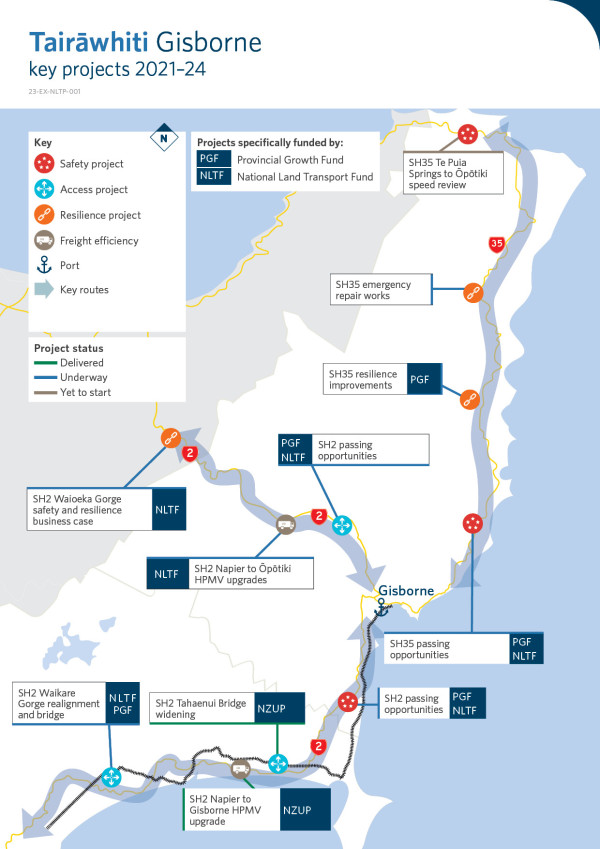Investment in the Tairāwhiti land transport system through the 2021-24 National Land Transport Programme (NLTP) is focused on supporting improved access to essential services and increasing resilience of the road network to get goods to market.
The topography of Gisborne — a hilly, mountainous interior, low-lying river plains and coastal flats — makes the region prone to erosion and slips. It is also vulnerable to the impact of climate change and extreme weather. The region’s relative isolation means businesses and communities rely on having access to safe, reliable transport to get their goods to domestic and international markets and to access essential services.
Keeping the land transport system maintained is a large part of the NLTP investment in Tairāwhiti. During the 2021-24 NLTP period, $326 million is forecast for maintenance and operations work across the region. Good progress on road renewal work was made during the 2022/23 summer maintenance season before Cyclone Gabrielle. Any works that were not able to be completed will be added to the 2023/24 programme.
Tairāwhiti has been hit by a series of significant weather events in the past few years, leaving extensive damage across the region. The scale of damage following Cyclone Gabrielle is significant, and it will take time to repair and rebuild.
Following Cyclone Gabrielle, the key links into and around Tairāwhiti have been reopened, and we’re using short-term measures to keep the region moving. Recovery works are ongoing.
We’re also working on a Tairāwhiti Wairoa Resilience Strategic Response which identifies a recommended broad rebuild work programme for the region. SH2 (Ōpōtiki to SH2/SH5 intersection), SH35 and SH38 are included in the programme. This work builds on existing strategic work already done in the region, including the Tairāwhiti Roading Package, applying a stronger focus on resilience. All future works are subject to funding.
Through the Tairāwhiti Roading Package (TRP), $13.5 million is being spent improving the reliability and resilience of SH35. This work is ongoing and includes native revegetation, retaining structures, retreats, and coastal erosion protection at 10 sites. Six sites have been completed with the remaining four to be complete by mid-2024.
We’re also investing in improvements through SH2 Waioeka Gorge, a key freight route for Gisborne. A detailed business case for this project was completed before the early 2023 cyclones hit the region. It is now being updated to align with the Tairāwhiti Wairoa Resilience Strategic Response and, subject to funding, could form the initial piece of work to improve the resilience and safety of this key route.
In this NLTP, we’re investing $3.6 million to maintain and develop Gisborne city’s public transport services. Funding for an improved ticketing system will see Gisborne’s public transport included in the National Ticketing Solution programme from mid to late 2026.
A strategic review of the city’s public transport system is also underway. The Regional Transport Committee will soon receive changes suggested by the review, aiming to approve recommendations by November 2023.
We’re on track to deliver 20 additional passing opportunities along SH2 and SH35, to reduce driver frustration and make overtaking safer. There will be a mix of new slow vehicle bays, extensions to existing slow vehicle bays, widened shoulders and mobile phone laybys. Eight sites are complete and the remaining 12 sites will be completed in the 2023/2024 financial year. This work is part of the Tairāwhiti Roading Package (TRP), at a cost of $33 million. The funding is allocated from Kānoa - Regional Economic Development & Investment Unit and the National Land Transport Fund.
Kānoa - Regional Economic Development & Investment Unit(external link)
Following the implementation of new safer speeds on SH35 in recent years, the way we manage speeds has recently changed. We now need to develop speed management plans with a whole-of-network approach every three years, aligning with the NLTP cycle. As this legislation has come into effect during the current 2021-24 NLTP period, Waka Kotahi has developed an Interim State Highway Speed Management Plan (ISMP) which includes remaining speed-related activities within the current NLTP.
The ISMP’s proposed changes for Gisborne aim to benefit children and their caregivers so they can feel safer walking or biking to kura, and tourists so they can confidently travel through our region to explore its beaches and rural beauty. Changes to speed limits on other sections of state highways in the region will be considered when we develop the full State Highway Speed Management Plan.
The Waka Kotahi national project, Improving Road Safety with Māori, under Road to Zero Te Ara Ki te Ora involves Te Tairāwhiti as one of the first regions to focus on. The impact of weather events, including Cyclone Gabrielle, has slowed progress on the project, however the work is ongoing, and we remain committed to doing better for Māori, making sure people are getting home safe to their whānau, hapū, iwi and hapori community.
|
NLTP - Gisborne |
Investment in 2022/23 |
Forecast investment for 2021-24 |
|
Total |
$170 million |
$388 million |
|
Maintenance and operations |
$157 million |
$326 million |
|
Public transport investment |
$1 million |
$3.6 million |
|
Walking and cycling |
$1.4 million |
$4 million |
|
Road to Zero (safety) |
$1 million |
$5 million |
|
Network improvements |
$2 million |
$11 million |
